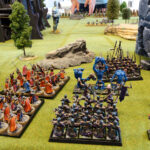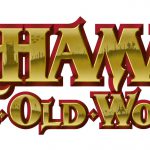About a week ago I wrote something about out of print games and shared my thoughts on whether these game are still enjoyable now that there is no support coming from the manufacturer of the game. I posted the link to my blog on various Facebook pages and received a lot of feedback on the subject. This led me to the idea of writing a follow-up, for some of the reactions provided me with more insight.
A lot of people responded with stating the out of print games they still play and that they agreed with me that these games are still very good and enjoyable as long as you can find enough people to play them with. In one of the threads we came to the idea that most people who still play these games once started with them when they were younger and perhaps still cling to them out of nostalgic reasons. For me this is indeed partly the case.
Another thing that was raised was the initial investment involved when the game leaves print. If you have invested a lot of money in a game the idea of just abandoning it when it becomes out of print is not very appealing. When the investment is neglectable and you need to invest a lot of time and effort to keep playing the game it is more likely you would drop the game as a whole. (How much ‘neglectable’ is for a wargamer is quite another discussion). One person told me that he once bought a starter set in a local comic shop and later found out the game had just gone out of production. Since the set had not cost that much in the first place he had no inclination to even start looking for players and scour the web for out of print supplements.
Anders Wänn also had an interesting point. He wanted to add an additional perspective on game design.
“Games design is a field that is constantly developing. And many of the out of print games that we enjoy nowadays have rules systems that are badly designed by modern standards. For older GW products it is often a problem with bloated systems. Common problems include: high threshold to start playing, lots of waiting for your turn, many tables and steps of dice rolling that adds time but not really strategy or meaningful choice, etc. Often the balance between RNG and strategy is not really consciously thought through and points values are _very_ badly balanced. In addition, several games use pretty much the same system, while modern game design puts emphasis on optimising rules for the specific feeling and stories in each game. And as players grow older and gain more responsibilities, time becomes much more valuable for them. So they have less patience with slow and badly balanced rules. (This is of course offset by nostalgia and the time saved by playing a system that is already well known). This difference in level of games design will be very noticeable for players who does not have the nostalgia and who have not already invested hundreds of hours into memorising all the rules of these OOP-games. Extra much so if they are used to playing games with sharper design. So that makes it harder to recruit new players.”
Again the nostalgia comes along. Could it be true that the older games will attract less new players because of the ‘out-dated’ games design? A few months ago I played a game of Necromunda with a friend of mine who just recently started to play tabletop wargames. He had enjoyed the game, but also mentioned the fact that he thought the game felt a bit sluggish. I have not convinced him to play another game (yet).
On the other hand, as Ant Loughlin pointed out, the game in itself has become a very solid platform.
“I tend to view Out of Print games, the ones that are still played, such as Necromunda, as pretty good investments. It’s sad that it isn’t as easy to justify as it is to others, but being unsupported means no chance of it being f***ed up, or the meta changing, so the game has a certain stability to enjoy as a functional experience.”
Once you have played the game several times and get acquainted with the basic rules you are certain there will be no more new supplements, rules changes and updates. So if you happen to like the game it is indeed as solid as you can get them.
After reading al the responses I thought it would also be interesting to see what someone who had been deeply involved in the making of games that are currently out of print thought about this subject .
Gav Thorpe is such a veteran games designer. He was kind enough to respond (and also incorporate some thoughts on the Age of Sigmar post).
“That’s a really interesting take. My initial thought is that it really depends on whether anything else comes out to directly replace it. For example, Blood Bowl has continued to be ridiculously popular without GW support for many years. Other specialist games like Mordheim and Epic also continue to have followings. On the other hand, Age of Sigmar has officially replaced WFB and is receiving the support, coverage and recruitment. It isn’t just a case of playing an old game, it’s playing a game the creators themselves have superceded.
It would be a bit like insisting on playing a video game but without certain patches, I suppose.
The decision at the moment for many players is a negative not a positive – they are deciding NOT to play AoS rather than making the choice to continue to play WFB, if that makes sense. On the other hand, time is a healer. Just as there is a pleasant Oldhammer movement perfectly content to continue alongside more modern gaming, so I think that communities will be around for other versions of WFB. The problem there is that while most Oldhammer players are fixated on 3rd ed, not all players agree on which later version is the best to play – roughly breaks down to 4/5th edition, 6/7th or 8th…”
The concept of the replacement game interested me. So I asked him of he thinks that Bloodbowl for instance would have had a smaller continuing fanbase if a good substitute would have been released (whether by GW or any other producer)? Or are people just to hooked on the background and stories etc. of the original version they started playing. I believe guilball has a nice following, but as far as I know not as large as the hordes that still play Bloodbowl. Even before the new edition was released not so long ago.
“Thing is, there have been close copies, but the third party market has done so well with ‘Fantasy Football’ teams (miniatures) that the main game has held up as a system to support. Close contenders like Dreadball and Guildball have moved away enough from the core BB image and mechanics that they offer something different rather than the same, making them complimentary rather than competition. The same hasn’t been so true of the more GW IP-specific games like Necromunda and Epic, although Inquisimunda has taken up some of that former community.”
All in all I still think that my initial statements of out of print games stand, but there are certainly more aspects to be found surrounding the topic.
I would like to thank all the people in the various groups for their responses and feedback. As far as I can tell one discussion even brought some gamers in contact with each other to start playing Necromunda and I enjoyed that very much. It goes to show that gaming communities can contribute a lot to the fun we all want to have playing the various games.
If there are more insights that you would like to share, please feel free to respond. I am always happy to hear from you all.
Cheers!







